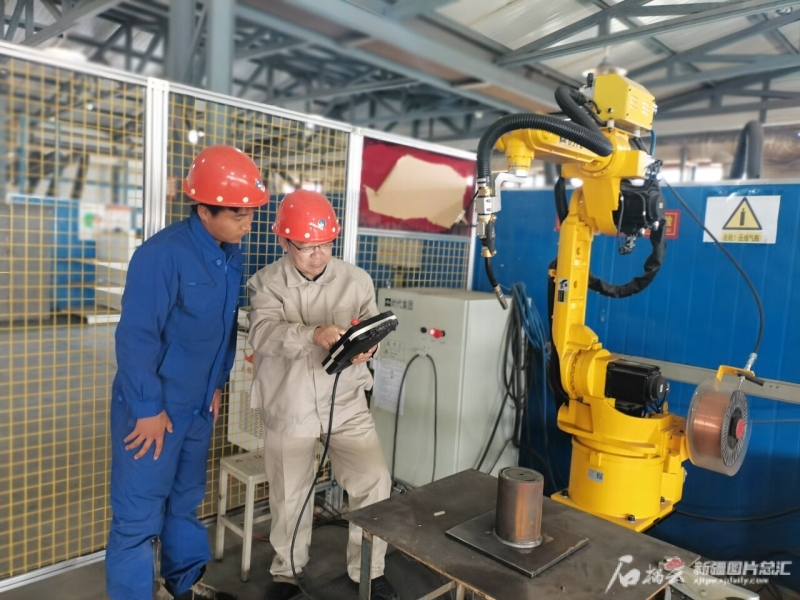Shiliuyun-Xinjiang Daily (Reporter Ren Chunxiang) news: At the age of 32, because of the teaching requirements, Liu Jiancheng started to learn welding from scratch. At the age of 57, because of the desire to explore a new teaching field, Liu Jiancheng started to learn the application technology of welding automation. Now, at the age of 58, he still bears an idea in mind that “Technology is constantly evolving as the society takes its steps, which requires us keep learning and digging deeper in the forever latest skills.”
Teaching at Xinjiang Industrial Vocational and Technical College (Xinjiang Iron and Steel Senior Technical School) for 38 years, Liu Jiancheng has been constantly improving himself in teaching, and with his guidance, his students achieved excellent results in vocational skill competitions at all levels. He is also the leader of the national skill master studio. Over the years, his welding skills has helped many enterprises and trained many highly skilled talents.

Photo taken on April 30, 2023 shows Liu Jiancheng (first from right) operates welding robot at the practice training room of Xinjiang Industrial Vocational and Technical College (Xinjiang Iron and Steel Senior Technical School) in Urumqi, northwest China’s Xinjiang. (Photo provided by Liu Jiancheng)
In 1985, Liu Jiancheng graduated from Liaoning Benxi Metallurgical College (now Liaoning Institute of Science and Technology) and was assigned to teach mechanical theory courses at the former Xinjiang Iron and Steel Technical School. In 1997, in order to meet the technical needs of enterprises, the school planned to offer a major in welding. As the head of the teaching and research department, Liu Jiancheng took the lead to make preparations for setting up the welder training studio.
Welding is a completely different major from the courses he taught before. Therefore, he needed to start learning welding from the basic operations. During the day, he taught students, and at night, he used spare time to learn from books. Even as a teacher, he had to memorize the complex welding steps in books by rote, figure out the difficult process parameters by himself, and practice the difficult operation techniques repeatedly. For him, the most difficult thing was to apply the theoretical principles to practical operations. “Being able to distinguish the subtle differences between molten iron and welding slag is considered beginner's level. After practicing for at least two hours a day for two months, I could finally tell the difference by colors,” Liu Jiancheng said.
After six months of self-study, he began to learn from welding technicians in enterprises to get more practical operating techniques. “Green hand would find welding suffers at first. Because they easily get burnt for being not proficient. These scars on my arms are my evidence.”
As improving professional skills, he focused on teaching welding after setting up the course. He would stay in the training studio every day to train students and employees of enterprises. The students he coached won the first prize in the Xinjiang Electric Welding Technology Competition, and the employees he coached won the eighth place in the welder competition of National Iron and Steel Industry Vocational Skills Competition.
Yang Qidong, an enterprise skill expert and a former student of Liu Jiancheng, is also a member of the studio. Yang Qidong said, “Mr. Liu is rigorous and meticulous, dedicated to studying. He is not only excellent at theory and exquisite skills, but also unreservedly passes on technical experiences, helping us achieve rapid advancement.”
Liu Jiancheng also works out the technical problems of enterprises. He and his team have obtained six patents for utility model and one patent for invention, saving millions of yuan for enterprises.
The aluminum alloy blade parts of a large hydraulic coupler used by an enterprise are prone to crack after using for a long time. The thickest part is less than 2 mm and the thinnest part is only 0.5 mm. Because the aluminum alloy is easy to oxidize when welding, and the thinnest part is easy to burn through when welding, making it difficult for repair. With high price and long cycle of maintenance, replacing the broken parts not only delays production, but also increases maintenance cost. Liu Jiancheng and the technical team tried and tested repeatedly, and successfully repaired the blades with special operation methods. This technique alone can save more than 200,000 yuan for enterprises in maintenance every year.
“In recent years, new methods, techniques, and equipment have emerged in welding technology. To support us in continuously exploring, expanding, and enriching teaching content, the school invested over 100,000 yuan on new teaching equipment and resources, and building training rooms,” Liu Jiancheng said. “Last year, the school purchased welding robots and planned to provide training for welding robot operators to cultivate teachers for welding robot operations. Operating welding robots requires both technical knowledge and programming skills, making it an emerging profession with great development prospects.”
Now, Liu Jiancheng starts to learn programming and operation of the welding robot. He would recite the steps for several times till it is successfully programmed. Then he would run the simulation before the actual operation. No matter how busy he is at work, he would squeeze out time every week to practice in the training room.
“As a teacher in vocational education, I will keep up with the pace of technological development, always keep learning, and cultivate more new high-skilled talents for society,” Liu Jiancheng said.
(A written permission shall be obtained for reprinting, excerpting, copying and mirroring of the contents published on this website. Unauthorized aforementioned act shall be deemed an infringement, of which the actor shall be held accountable under the law.)









